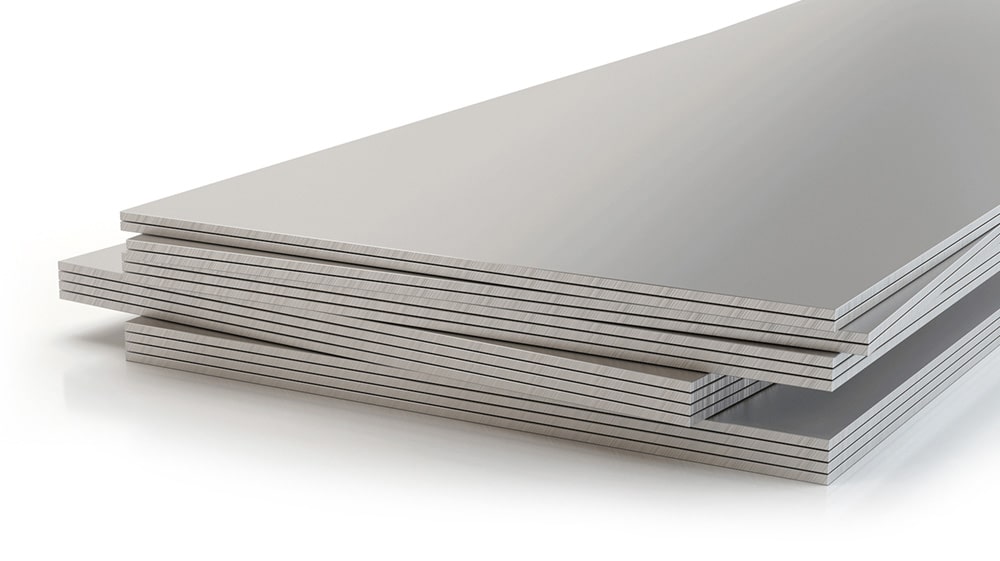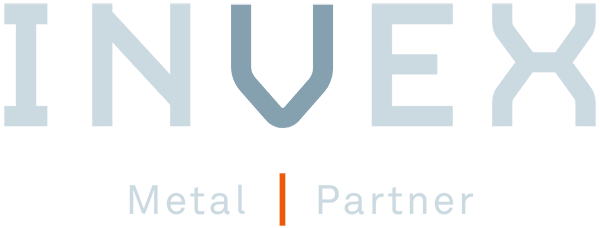Do you need a metal that conducts heat and electricity well and has high corrosion resistance? Then aluminium might be a good choice. Aluminium can also be alloyed to high strength and processed by most known methods.
Aluminum
We offer aluminium bars, plates, sheets and tubes in a variety of alloys and tempers, shown in the list below.
For special requirements, please don’t hesitate to contact us for a solution!

Products
Roundbars

Designation
2007/2030
2033 (Pb≤0,05%)
2011
5754
5083
6026LF
6082
7050
7075
Dimensions
20-100mm
5-250mm
20-65mm
≤200 mm
≤200 mm
6-250 mm
≤450 mm
≤400 mm
≤400 mm
Plate/sheets

Designation
1050
2024 (blank/clad)
5754 (blank/tread)
5083
6082
7020
7050
7075
7475
Thickness
0.5-60 mm
0.5-101.6 mm
0.5-5.0 mm
1-200 mm
1-150 mm
2-100 mm
25.4-152.4 mm
20-152 mm
12.7-101.6 mm
Series
> The 1000 series, unalloyed aluminium
When the alloy contains at least 99.00% aluminium, it is generally designated pure aluminium. These alloys have low strength, excellent malleability and conductivity, and good corrosion properties. Typical applications include packaging, cooking pans and electrical cables.
2000 series, Cu alloys
Aluminium gets its strength by adding different alloy elements. Adding copper produces a material with very high strength, but the drawback is that it has relatively poor welding and corrosion properties. Typical applications are in aircraft, machine parts, bolts and rivets.
5000 series, Mg alloys
Adding magnesium helps to increase the material’s strength. Good corrosion resistance. Alloys with more than 3% magnesium are sometimes designated seawater-resistant aluminium. The 5000 series is a typical sheet metal alloy used in construction and shipbuilding.
6000 series, Mg-Si alloys
Adding both magnesium and silicon gives a hardenable alloy that’s ideal for extrusion. These alloys have good properties as regards weldability, corrosion resistance, milling and electrical conductivity.
The strength can also be relatively high. The alloy is well suited to anodising and is often used for decorative objects.
The 6000 series is the most common alloy for aluminium profiles, and it has a wide range of applications.
7000 series, Zn-Si alloys
These are very strong alloys. Adding zinc and manganese achieves not only strength, but also good corrosion and welding properties. These alloys can be hardened and are among the strongest. Typical applications are welded constructions that are exposed to heavy mechanical strain. Automotive, aerospace and defence are some of the sectors that use this type of alloy.
Characteristics / alloys
Group 1 – non-heat-treatable
Designation
1050
Al99.5
Used in
ENAW 1050 – Unalloyed aluminium with low strength values and the most common sheet alloy. This alloy has good properties for bending and welding, and is suitable for surface treatment. Good corrosion properties, sensitive to scratching, has a wide range of applications.
It contains 99.5% aluminium and is produced in plates/sheets, primarily in thicknesses of 0.5–6 mm. Also available in round bars, although this is quite unusual.
1200
Al 99.0
Unalloyed aluminium, good corrosion properties, good malleability.
Contains Al 99.0%.
5754
AlMg3
A very common sheet metal alloy. It is saltwater resistant (high corrosion resistance) and has average strength. Good weldability and average for anodising.
5083
Almg4.5 Mn0.7
High strength. Good corrosion properties. Mainly used in the marine sector.
Group 2 – heat-treatable
2007
AlCu4PbMgMn
An alloy with a high copper content (4-5%). Similar to EN AW-2011 in terms of properties. It is a short chip alloy with excellent machinability. Used for advanced machining and high-strength applications in e.g. machine components, bolts and rivets. The alloy has lower corrosion resistance, and is not suitable for welding due to its high copper content. A less good grade for anodising.
2011
AlCu6BiPb
An alloy with a high copper content (4-5%). Similar to EN AW-2007 in terms of properties. It is a short chip alloy with excellent machinability. Used for advanced machining and high-strength applications in e.g. machine components, bolts and rivets. The alloy has lower corrosion resistance, and is not suitable for welding due to its high copper content. A less good grade for anodising.
2014
AlCu4SiMg
An alloy with a high copper content (4-5%). Similar to EN AW-2007 and EN AW-2011 in terms of properties. It is a short chip alloy with excellent machinability and high strength. Commonly used in the aerospace and defence industries.
2017
AlCu4MgSi
An alloy with a high copper content. It is a short chip alloy, suitable for machining.
The alloy has low corrosion resistance and is not suitable for welding due to its high copper content. Not suitable for decorative anodising.
2024
AlCu4Mg1
An alloy offering high strength. Moderate corrosion resistance. Used in the defence industry. Aerospace.
2033LF
AlCu4Mg
An alloy with max. 0.1% lead. Turning alloy. Good strength. Almost lead-free. Otherwise as 2024.
4032
AlSiCuMgNi
A high-strength, abrasion-resistant alloy that’s weldable, corrosion resistant and is excellent for machining.
6026
Has similar properties to EN AW-6082, but is easier to machine as it is a short chip alloy. Average welding, corrosion and anodising properties.
6026LF
AlMgSiPbLF
Max. 0.1% lead. Turning alloy. Good strength. Almost lead-free. Good corrosion resistance. The most widely used turning alloy.
6061
AlMg1SiCu
Suitable for decorative anodising and offers high corrosion resistance. Also suitable for welding.
6082
AlSi1MgMn
High strength and good corrosion resistance. The alloy is suitable for welding and can be anodised.
7010
AlZn6.2MgCuZr
A short chip alloy with very high strength. The alloy has low corrosion resistance and is not suitable for welding or anodising.
7020
AlZn4.5Mg1
A short chip alloy with very high strength. The alloy has low corrosion resistance and is not suitable for anodising. Better weldability than other 7000 series alloys.
7050
AlZn6.2MgCuZr
An aerospace-grade, high-performance alloy, can withstand stress corrosion.
7075
AlZnMgCu1.5
A short chip alloy with very high strength. The alloy has low corrosion resistance and is not suitable for welding or anodising.
7475
AlZn5.5MgCu
A high-strength alloy of aerospace grade. Moderate corrosion resistance. Used in aerospace and defence.
Condition
F – As fabricated (no limits for mechanical properties stated)
O – Annealed – Products that achieve the properties stated for annealed alloys after heat treatment are designated O temper.
O1 – Heat treated at roughly the same time and temperature as required for dissolution treatment and slowly cooled to room temperature (formerly designated T41).
H12 – Work hardened to quarter hard
H14 – Work hardened to half hard
H16 – Work hardened to three-quarter hard
H18 – Work hardened to fully hard
H19 – Work hardened to extra hard
Hxx4 – Refers to embossed or patterned sheet metal, tape made from the corresponding Hxx temper.
Hxx5 – Work hardened, refers to welded pipes.
H111 – Annealed and lightly cold worked (less than H11) through subsequent processing such as elongation or flat milling.
H112 – Lightly work hardened or heat treated, or following limited cold working (limits for mechanical properties stated).
H116 – Refers to aluminium-magnesium alloys with Mg content of 4% or above, for which limits for mechanical properties and layer-corrosion resistance have been set.
H22 – Work hardened and annealed to quarter hard
H24 – Work hardened and annealed to half hard
H26 – Work hardened and annealed to three-quarter hard
H28 – Work hardened and annealed to fully hard
H32 – Work hardened and stabilised – quarter hard
H34 – Work hardened and stabilised – half hard
H36 – Work hardened and stabilised – three-quarter hard
H38 – Work hardened and stabilised – fully hard
H42 – Work hardened and coated – quarter hard
H44 – Work hardened and coated – half hard
H46 – Work hardened and coated – three-quarter hard
H48 – Work hardened and coated – fully hard
W – Solution heat treated (unstable temper). A time for natural ageing after quenching (W 2h…) may also be stated.
T3 – Solution heat treated, cold worked and naturally aged.
T4 – Solution heat treated and naturally aged.
T42 – Solution heat treated and naturally aged. Relates to samples heat treated from annealed or F state, or products heat treated by the customer from any temper.
T451 – Solution heat treated, relaxation treated through elongation by a stipulated degree (remaining deformation 0.5% to 3% for plate/sheet under 6mm, 1.5% to 3% for plate/sheet 6mm and above, 1% to 3% for rolled or cold-drawn bar, 1% to 5% for free or ring forging and rolled ring) and then heat aged. The products undergo no further straightening after elongation.
T6 – Solution heat treated and heat aged.
T651 – Solution heat treated, relaxation treated through elongation by a stipulated degree (remaining deformation 0.5% to 3% for plate/sheet under 6mm, 1.5% to 3% for plate/sheet 6mm and above, 1% to 3% for rolled or cold-drawn bar, 1% to 5% for free or ring forging and rolled ring) and then heat aged. The products undergo no further straightening after elongation.
T6510 – Solution heat treated, relaxation treated through elongation by a stipulated degree (remaining deformation 1% to 3% for extruded bar, profile and pipe, 0.5% to 3% for drawn pipes) and then heat aged. The products undergo no further straightening after elongation.
T6511 – As T6510 although light straightening is permitted after elongation to achieve standardised tolerances.
T7 – Solution heat treated and overaged.
T7351 – Solution heat treated, relaxation treated through elongation by a stipulated degree (remaining deformation 0.5% to 3% for plate/sheet under 6mm, 1.5% to 3% for plate/sheet 6mm and above, 1% to 3% for rolled or cold-drawn bar, 1% to 5% for free or ring forging and rolled ring) and then overaged to achieve the best stress and corrosion resistance. The products undergo no further straightening after elongation.
T76510 – Solution heat treated, relaxation treated through elongation by a stipulated degree (remaining deformation 1% to 3% for extruded bar, profile and pipe, 0.5% to 3% for drawn pipes) and then overaged to achieve the best layer corrosion resistance. The products undergo no further straightening after elongation.
T76511 – As T76510 although light straightening is permitted after elongation to achieve standardised tolerances.
T8 – Solution heat treated, cold worked and heat aged.
